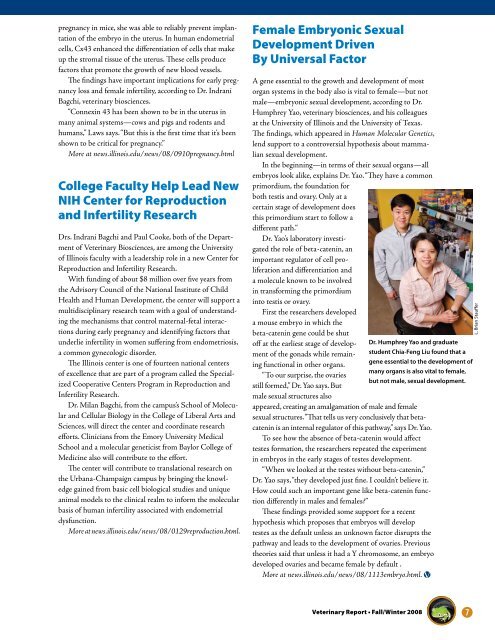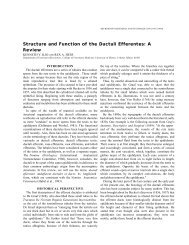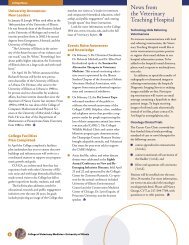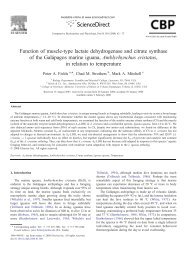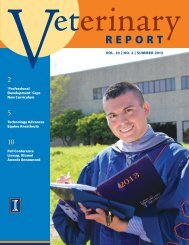rePort - University of Illinois College of Veterinary Medicine ...
rePort - University of Illinois College of Veterinary Medicine ...
rePort - University of Illinois College of Veterinary Medicine ...
Create successful ePaper yourself
Turn your PDF publications into a flip-book with our unique Google optimized e-Paper software.
pregnancy in mice, she was able to reliably prevent implantation<strong>of</strong> the embryo in the uterus. In human endometrialcells, Cx43 enhanced the differentiation <strong>of</strong> cells that makeup the stromal tissue <strong>of</strong> the uterus. These cells producefactors that promote the growth <strong>of</strong> new blood vessels.The findings have important implications for early pregnancyloss and female infertility, according to Dr. IndraniBagchi, veterinary biosciences.“Connexin 43 has been shown to be in the uterus inmany animal systems—cows and pigs and rodents andhumans,” Laws says. “But this is the first time that it’s beenshown to be critical for pregnancy.”More at news.illinois.edu/news/08/0910pregnancy.html<strong>College</strong> Faculty Help Lead NewNIH Center for Reproductionand Infertility ResearchDrs. Indrani Bagchi and Paul Cooke, both <strong>of</strong> the Department<strong>of</strong> <strong>Veterinary</strong> Biosciences, are among the <strong>University</strong><strong>of</strong> <strong>Illinois</strong> faculty with a leadership role in a new Center forReproduction and Infertility Research.With funding <strong>of</strong> about $8 million over five years fromthe Advisory Council <strong>of</strong> the National Institute <strong>of</strong> ChildHealth and Human Development, the center will support amultidisciplinary research team with a goal <strong>of</strong> understandingthe mechanisms that control maternal-fetal interactionsduring early pregnancy and identifying factors thatunderlie infertility in women suffering from endometriosis,a common gynecologic disorder.The <strong>Illinois</strong> center is one <strong>of</strong> fourteen national centers<strong>of</strong> excellence that are part <strong>of</strong> a program called the SpecializedCooperative Centers Program in Reproduction andInfertility Research.Dr. Milan Bagchi, from the campus’s School <strong>of</strong> Molecularand Cellular Biology in the <strong>College</strong> <strong>of</strong> Liberal Arts andSciences, will direct the center and coordinate researchefforts. Clinicians from the Emory <strong>University</strong> MedicalSchool and a molecular geneticist from Baylor <strong>College</strong> <strong>of</strong><strong>Medicine</strong> also will contribute to the effort.The center will contribute to translational research onthe Urbana-Champaign campus by bringing the knowledgegained from basic cell biological studies and uniqueanimal models to the clinical realm to inform the molecularbasis <strong>of</strong> human infertility associated with endometrialdysfunction.More at news.illinois.edu/news/08/0129reproduction.html.Female Embryonic SexualDevelopment DrivenBy Universal FactorA gene essential to the growth and development <strong>of</strong> mostorgan systems in the body also is vital to female—but notmale—embryonic sexual development, according to Dr.Humphrey Yao, veterinary biosciences, and his colleaguesat the <strong>University</strong> <strong>of</strong> <strong>Illinois</strong> and the <strong>University</strong> <strong>of</strong> Texas.The findings, which appeared in Human Molecular Genetics,lend support to a controversial hypothesis about mammaliansexual development.In the beginning—in terms <strong>of</strong> their sexual organs—allembryos look alike, explains Dr. Yao. “They have a commonprimordium, the foundation forboth testis and ovary. Only at acertain stage <strong>of</strong> development doesthis primordium start to follow adifferent path.”Dr. Yao’s laboratory investigatedthe role <strong>of</strong> beta-catenin, animportant regulator <strong>of</strong> cell proliferationand differentiation anda molecule known to be involvedin transforming the primordiuminto testis or ovary.First the researchers developeda mouse embryo in which thebeta-catenin gene could be shut<strong>of</strong>f at the earliest stage <strong>of</strong> development<strong>of</strong> the gonads while remain-student Chia-Feng Liu found that aDr. Humphrey Yao and graduateing functional in other organs. gene essential to the development <strong>of</strong>many organs is also vital to female,“To our surprise, the ovariesbut not male, sexual development.still formed,” Dr. Yao says. Butmale sexual structures alsoappeared, creating an amalgamation <strong>of</strong> male and femalesexual structures. “That tells us very conclusively that betacateninis an internal regulator <strong>of</strong> this pathway,” says Dr. Yao.To see how the absence <strong>of</strong> beta-catenin would affecttestes formation, the researchers repeated the experimentin embryos in the early stages <strong>of</strong> testes development.“When we looked at the testes without beta-catenin,”Dr. Yao says, “they developed just fine. I couldn’t believe it.How could such an important gene like beta-catenin functiondifferently in males and females?”These findings provided some support for a recenthypothesis which proposes that embryos will developtestes as the default unless an unknown factor disrupts thepathway and leads to the development <strong>of</strong> ovaries. Previoustheories said that unless it had a Y chromosome, an embryodeveloped ovaries and became female by default .More at news.illinois.edu/news/08/1113embryo.html.L. Brian Stauffer<strong>Veterinary</strong> Report • Fall/Winter 2008u


